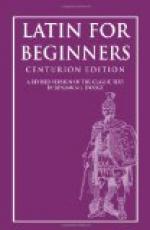1. ama:re:’mus mone:re:’mus regere:’mus capere:’mus audi:re:’mus 2. ama:re:’tis mone:re:’tis regere:’tis capere:’tis audi:re:’tis 3. ama:’rent mone:’rent re’gerent ca’perent audi:’rent
PASSIVE 1. ama:’rer mone:’rer re’gerer ca’perer audi:’rer 2. ama:re:’ris mone:re:’ris regere:’ris capere:’ris audi:re:’ris (-re) (-re) (-re) (-re) (-re) 3. ama:re:’tur mone:re:’tur regere:’tur capere:’tur audi:re:’tur
1. ama:re:’mur mone:re:’mur regere:’mur capere:’mur —re:’mur 2. ama:re:’mini: mone:re:’mini: regere:’mini: capere:’mini: —re’mini: 3. ama:ren’tur mone:ren’tur regeren’tur caperen’tur —ren’tur
a. In a similar way inflect
the imperfect subjunctive, active and
passive, of curo\, iubeo\, sumo\, iacio\,
munio\.
355. The imperfect subjunctive of the irregular verb sum\ is inflected as follows:
{ 1. es’sem { 1. esse:’mus
SING. { 2. es’se:s PLURAL { 2. esse:’tis
{ 3. es’set { 3. es’sent
356. The three great distinctions of time are present, past, and future. All tenses referring to present or future time are called primary tenses\, and those referring to past time are called secondary tenses\. Now it is a very common law of language that in a complex sentence the tense in the dependent clause should be of the same kind as the tense in the principal clause. In the sentence He /says\ that he /is\ coming, the principal verb, says, is present, that is, is in a primary tense; and is coming, in the dependent clause, is naturally also primary. If I change he says to he said,—in other words, if I make the principal verb secondary in character,—I feel it natural to change the verb in the dependent clause also, and I say, He /said\ that he /was\ coming. This following of a tense by another of the same kind is called tense sequence, from sequi:, “to follow.”
In Latin the law of tense sequence is obeyed with considerable regularity, especially when an indicative in the principal clause is followed by a subjunctive in the dependent clause. Then a primary tense of the indicative is followed by a primary tense of the subjunctive, and a secondary tense of the indicative is followed by a secondary tense of the subjunctive. Learn the following table:
357. TABLE FOR SEQUENCE OF TENSES
+-----+-------------------+----------------------------




